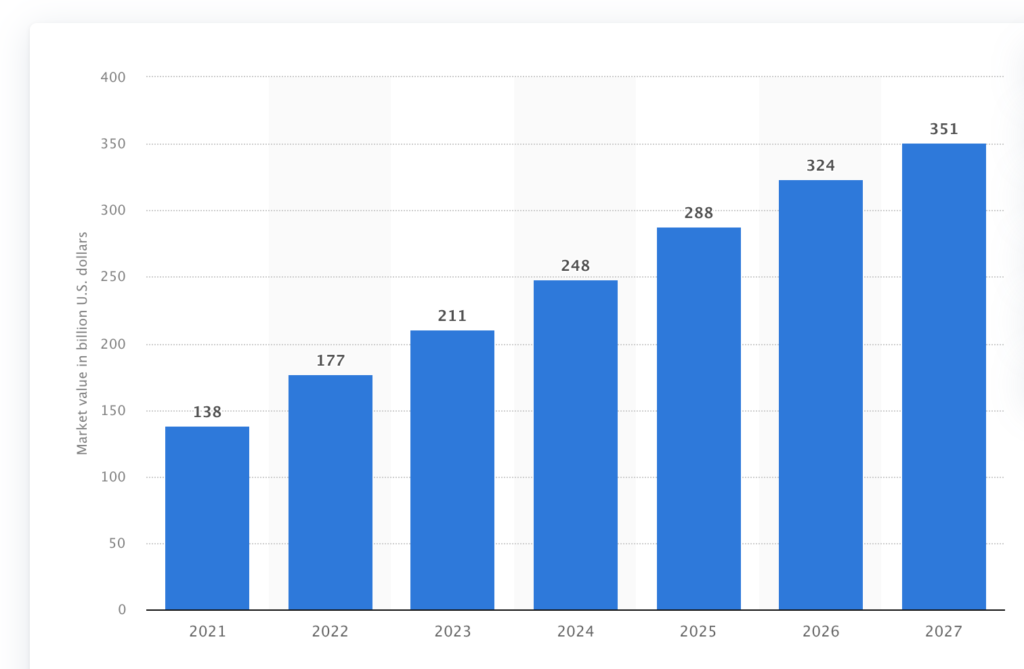Statista indicates that the second hand market has a whooping estimated worth of 177 billion dollars globally. That fact, combined with the growing trend in sustainable fashion and budget friendly living, means that there has never been a more opportune time to start a second hand clothing store online.
Starting an Online Thrift Store

Starting an online thrift store is a suitable entrepreneurship model for fashionists, budding hustlers seeking who want to earn an solid income online, and any person that is passionate about promoting conscious consumerism.
The rapid shift to the digital landscape, fuelling the phenomenal growth of the ecommerce, social commerce and mobile ecommerce, indicates that more and more consumers prefer to browse through preloved apparel from the comfort of their homes and their mobile devices.
Online thrifters that have gotten the formula right over the past years have struck gold as their platforms have become household brands for snag and unique fashion apparels sold at highly competitive prices.
Second Clothing and Environmental Consciousness
If you don’t feel you have sufficient rationale to go for this, one major reason why the thrifting business is making waves is that the sector has contributed immensely towards lowering the acute carbon footprint of the fashion industry.
The fashion industry is one of the biggest polluters on the planet with an estimated 10% of carbon emissions. Selling and buying second hand clothes extends the life cycles of clothes, preventing these from landing in the landfills and lowering the cut throat demands of manufacturing new clothes which significantly contributes to pollution and environmental damage.
In the previous post we published a comprehensive guide on how to start an online clothing store with no inventory. In this post we want to take you through the step by step journey, meat and bones of how you can start a second hand clothing store online.
The guide covers the entire gamut, from business ideation to implementation and scaling. We also share a link to the Online Thrift Store Business Plan PDF.
Market Research and Planning
One first and critical step of launching into the second hand clothing sector is to conduct thorough market research and to create a solid plan for your business.
Market research and planning involves identifying your target audience, analysing the competition as well as establishing what your unique selling point (USP) or distinctive is going to be. Below are some key principles to consider:
Identifying your target audience and niche
You need to identify who your ideal and target customers are, establish their demographics, preferences as well as consumer behaviours. This enables them to know how to frame your product offerings and where to pitch your brand.
Deal with questions such as: are you targeting vintage fashion enthusiasts, eco-consumers or you are simply aiming at budget-conscious shoppers. Answering this process is a big part of niching down which enables you to tailor your product offering to a laser focused market segment, and thereby enhances the prospects of your success.
Analyzing the competition and identifying unique selling points
Market research and planning also involves researching existing online thrift stores and evaluating their strengths and weaknesses. Look at what the existing thrifting landscape offers, what are the gaps that you can realistically plug at a profit?
That would be your niche. You may settle for selling curated second hand clothing styles, or focusing on sustainable and ethically sourced garments, etc.
Creating a Business Plan and Setting Goals
Many online entrepreneurs overlook the important step of creating a business plan and setting business goals. Developing a business plan enables you to outline your vision, mission and business strategy.
A solid business plan includes financial (costs, revenue, profits) projections, a marketing strategy and operational workflows.
A business plan enables you to see how realistic your idea is in the short term and long term. The business plan also becomes a tool you can use to evaluate your business.
Conducting the market research, creating a solid second hand clothing business plan with clear goals will inform the decisions about the range of your products (catalogue and inventory), branding, pricing as well as marketing.

Secondhand Apparel Market Value Worldwide Projections in Billion US Dollars (2021 to 2027), Source: Statista
Sourcing Inventory
What is an online second hand clothing store without inventory? Sourcing inventory for your online second hand store is the next crucial step in your workflow to start such a venture. You need research and identify suppliers that offer diverse and high quality products that satisfy your identified niche.
Below are some options you should consider when prospecting for second hand clothing inventory:
Exploring various sources for second-hand clothing
Thrift stores: Take a trip to your prospective thrift suppliers and have a look at their product offerings. Pay particular attention to the quality of the fabric, range and diversity of the apparel products as well as pricing. In doing this, establish a relationship with the supplier.
Wholesalers: Look for wholesalers who have capacity to sell your second hand clothing in bulk and at good (profitable) prices.
Individuals: Don’t overlook reaching out to individuals who are keen to get buyers for their good quality preloved clothing. The best places to do this is in online platforms, forums, social media groups as well as local community networks.
Here are some of the top second hand clothing wholesalers
Google Search Queries to Find Second Hand Clothing Suppliers
The other efficient way to find second hand clothing wholesalers and suppliers is to run Google searches related to your location: Some examples searches are:
- Where to buy second hand clothes in bulk in [your town]
- imported second hand clothes [your town]
- good quality second hand clothes for sale
- second hand clothing bales in [your town]
- second hand clothes sellers near me
- second hand clothes for sale in bulk
Consignment: Additionally, explore the option of partnering with individuals and consignment brands that allow them to sell their merchandise at a commission.
The bottom-line is to build relations with brands, shops, individuals and any entity of relevance to your business model.
Tips for selecting quality inventory
There is some due diligence you need to exercise in order to ensure a quality second hand inventory:
- Assess the quality of the garments and ensure these are in good condition and made from quality fabric.
- Inspect the garments for any wear and tear, stains and any possible damages
- Limit your focus to products that align with your brand and target market
- Curate the products and build an assortment of quality and unique pieces that will make your second hand online store stand apart.
- Pay attention to the seasonality of these items and plan your inventory accordingly.
Building an Online Second hand Clothing
Building a solid online store involves a few critical steps outlined below:
Choosing the right e-commerce platform
A wrong choice of an ecommerce platform will affect your business negatively. A good ecommerce platform offers robust features and functions that enable you to set up a high end online store which is friendly, mobile responsive and highly customisable.
Additionally, a good platform has affordable and elegant pricing options and tiers that allow you to take only packages (tools and features) that you need and scale to higher packages when it becomes necessary.
Top 5 Ecommerce Platforms For A Second-Hand Clothing Store Online
1. Shopify

Shopify is by a huge stretch, the best and most popular ecommerce platform for launching a second hand clothing store. The platform is the biggest and most popular by market share.
This is driven by the robust features and the user-friendly interface that Shopify provides for merchants to create their online stores. Shopify has powerful inventory management functions, extensive and highly customisable themes.
What also makes Shopify stand apart is its vast ecosystem of apps that enable third party integrations to extend the functionalities of your online store beyond the default settings.
With over a 100 payment gateway options, Shopify’s scalability and in-built digital marketing and SEO features make this brand an excellent choice for launching and growing a second hand clothing store online.
Shopify has the biggest market share and is the most popular ecommerce platform for retailers. The platform presents a vast range of features, templates and apps that you can leverage for integrations to extend the functionalities of your online store.
2. BigCommerce

Bigcommerce is another top contender in the ecommerce platforms arena. The platform is renowned for its robust inventory management modules and is another great fit for an online clothing store.
Bigcommerce also has a wide range of templates, design and customisation capabilities. The platform has also mastered SEO, omni channel selling, mobile friendliness and is therefore another great option for starting a second hand clothing ecommerce.
3. Wix

If budget is a big concern for you, Wix is another solid and cheaper ecommerce platform for clothing retailers. The platform offers high end and visually appealing templates.
The drag and drop store design interface makes it easy to set up a professionally designed store in minutes. Wix provides the essentials of running a secure online store: product listings, payment gateway integration and order management. The platform however has scalability and customisation limitations.
4. Squarespace

Squarespace is a visually oriented ecommerce platform which makes it one of the great options for launching an online clothing venture. The platform offers elegant themes and user-friendly design tools.
The platform also provides eCommerce essentials such as inventory management, payment gateways and order management. This platform is a good fit for small scale, second clothing stores that have a knack for curated aesthetics and design.
5. Ecwid

Ecwid is a great option for budget friendly online clothing stores that can be easily embedded into traditional stand-alone websites or social media platforms. Ecwid offers the key functionalities (stock management, online payment, order tracking) for setting up and managing an online store.
Ultimately the best choice for an ecommerce platform will be determined by your unique needs, preferences and budget.
A Standalone Website Versus an ECommerce Platform
When creating an online store, it is better to leverage solid ecommerce platforms like Shopify, BigCommerce, Wix, Squarespace and Ecwid as opposed to creating your own stand-alone online store website.
The reason for this is that going the ecommerce platform route saves the intricacies and the costs of ensuring that you have a user friendly, secure, search engine optimised online store. Also, a good ecommerce platform will save you a lot of headaches and costs that come with hiring developers to integrate payment gateways with your shop.
Remember that for your online store to be user friendly and to cater to a diverse pool of demographics and locations, the store must be integrated with more than just one payment gateway.
At least 10 payment gateway integrations is a good shot. Now think about the cost and the busywork that comes with getting a third party to do that. Whereas Shopify offers over 100 payment gateway integration options off the shelf for example.
If you still choose to go the route of designing your own second hand clothing online store website make sure the online store is visually appealing and user-friendly. Setup a followable and intuitive navigation and make use of high quality images for your products displays.
Consider procuring the services of experienced professionals to handle the design and the search engine optimisation (SEO) aspect of your store. SEO is what will ensure that your online store pages have keyword relevant meta tags and titles.
This will enhance the prospects of your store to be indexed and ranked on search engines, increasing the chances of your store pages getting organic traffic from Google and other search engines. Also pay attention to the site load speed of your online store.
Hire a professional to ensure your site has between 85% and 100% site load speed according to Google’s PageSpeedInsights.
Setup as many payment gateways as possible and also implement a user-friendly checkout process.
Inventory Management and Organization
Efficient Inventory Management
Inventory management is the backbone of your second hand online clothing store. You need to leverage inventory/stock management tools to track your inventory levels, generate sales reports and monitor sales patterns. This is crucial for the smooth running of our online thrift store.
Create Relatable Product Categories
You have to be intentional about how your product catalogue is set up. Organise your product categories such that customers can search and browse through your catalogue using filters like type of clothing (tops, bottoms, caps, shoes, etc), color, size, gender, brand, etc.
Pricing strategies for second-hand clothing

Be realistic about how you want to set up pricing for your second hand product line. Set a mark up according to your business plan, goals and target audience. Remember that second hand clothes can not be priced like brand new items.
In setting prices for these you need to consider factors such as brand desirability, condition of the apparel, brand and the original price of the item. Deploy discounts and promotions strategically to drive up sales as an entry wedge and also in dry seasons when you need to bump up your cash flow.
Maintain the quality controls you implemented when sourcing your products. Some items may have gotten damaged, stained or torn in the process. Make sure everything you set up is of good and desirable quality such as you would buy yourself.
The image you upload for product displays must match the actual condition of the products that you are selling. This will enhance your customer service and reduce the rate of returns and exchanges.
Managing Inventory Turnover
Inventory turnover management is a critical workflow in your online store business management. This involves keeping track of popular items, so that you invest more on these and always ensure there is always sufficient supply of these. Also keep tabs on slow moving items.
Do your maths and consider the medium to long term patterns to decide whether to replace the slow moving items or rather introduce strategic discounts, promotions or bundles as a way to ramp up sales velocity.
In addition, you need to source items that are in tandem with fashion trends and prevailing customer vibes and preferences to boost your overall inventory turnover.
Invest More on Popular Items and Promote Slow moving Items
Keep track of the popularity and demand for different items in your inventory. Identify slow-moving items and consider implementing strategies like discounts or bundling to improve their sales velocity.
Focus on sourcing items that align with current fashion trends and customer preferences to increase inventory turnover.
Efficient inventory management ensures smooth operations, a seamless shopping experience for your customers, minimal mishaps and errors, contributing to the overall success of your business.
Marketing and Promotion
Setting up a solid online second hand clothing store is one big piece of the puzzle, marketing and promoting your store is another important half. Below are some strategies you can consider for your digital clothing store.
Creating A Brand Identity And Consistent Branding
Maintain a strong and consistent brand identity across the online and offline fronts. Put thought into your brand name, color scheme, logo as well as overall aesthetics.
It is beneficial to maintain a consistent branding across your online store (website), social media platforms and offline marketing collaterals. This will help you to build a cohesive and recognisable brand.
Leverage Social Media Powerfully
There is creating pages on social media and posting a few product images now and again, and there is leveraging social media powerfully.
The latter involves using social media listening and monitoring tools to keep tabs on brand mentions, gauge consumer sentiment and stay in the loop of the ever evolving wants, needs and preferences of your target market.
Part of this strategy ate the basics of engaging your audience, responding to comments and building a vibrant community around your brand.
Social media plays a vital role in social proofing your business, giving your leads confidence to convert to paying customers.
Also consider tapping the benefits of emailing marketing to build a community (subscriber list) of your loyal customers. Email marketing enables you to convey discounts and promotions to your warm leads in the form of your captive audience ( subscriber list).
With such a community you can announce new product arrivals, encouraging customer engagement to spark new as well as repeat purchases.
Also consider implementing content marketing and getting into influencer collaborations with names that align with your brand and vision.
Publishing blog posts, video content on tips, styling ideas and industry insights is a great way of establishing your brand as an authority as well as generating new leads into the sales funnel.
How to start an online thrift store on Instagram
Instagram is an image and video media driven platform. This makes Instagram a popular platform for growing a visual product line like a clothing business.
Steps to Start an Online Second Hand Store on Instagram
- To start an online thrift store on Instagram all you need to do is to create an Instagram business account.
- Optimise your Instagram profile with your niche-relevant keywords
- Link your Instagram profile to your online store
- Publish high quality product visuals to engage with your Instagram audience
- Make use of curated captions and comments and also leverage relevant hashtags to boost visibility
Always make use of social media listening and monitoring tools to keep your ears on the ground for any trends and engagements related to the brand and the products you are selling.
Providing Excellent Customer Experience
The quality of the service you offer is a major determinant to the success of your online thrift store. Quality customer services creates happy customers, happy customers become your unpaid sales reps by a way of word of mouth referrals. To achieve a high quality customer service ensure the following:
Use high quality images and accurate product descriptions: This will increase the trust flow and credibility of your store. Also make sure you provide accurate descriptions of your clothing items such as fabric details, measurements and any imperfections.
The key here is to provide as much information about the product that customers need to make informed decisions. There should not be a disconnect between what your prospective customers online (from the pictures), and the actual product.
Again, if you leverage top ecommerce platforms like Shopify, BigCommerce, you will have important aspects of customer service taken care of off the shelf. These include aspects such as ensuring secure payment options that guarantee data privacy (Badges and SSL certificates), intuitive personalisations and wish lists, collecting and using customer feedback, etc.
What is also crucial in your customer service strategic workflow is to set up a solid and easy to follow returns mechanism. Even if you do everything by the book and do your best to offer the best customer service, some customers may feel they need to return a certain product for one reason or the other.
The principles of an efficient returns mechanism are: 1) Establishing a clear, easy-to-follow and fair returns policy, 2) being responsive to feedback (emails, comments, reviews and phone calls), 3) Implement an efficient returns process and workflow, 4) enable customers to initiate the returns process easily.
The aim here is to turn an unhappy customer into a highly satisfied one.
Shipping and Logistics
Shipping and Logistics is what will get the products customers from your store to your customers’ door step. There can be no successful online second and store without efficient shipping and logistics. To implement efficient shipping and logistics consider the following:
The Balance of Efficiency and Pricing
Look for shipping and logistics suppliers that strike the often elusive balance of efficiency and pricing. What you need here is a reliable shipping partner or fulfilment center that offers competitive rates and solid delivery services.
Factors to consider are order tracking capabilities, shipping turnaround (speed), and cost. A critical aspect of this is calculating shipping costs accurately based on dimensions, weight, and ultimate destination of the package.
Packaging and labelling guidelines for second-hand clothing
Ensure that you implement appropriate packaging for your second hand clothes in transit. Make use of materials such as poly mailers, bubble wrap or garment bags to prevent damages.
Pay attention to details by including shipping labels, return address labels as well as any important customs documents for international shipments.
Streamlining the fulfilment process
Managing international shipping and customs
If you aim to sell to a global market you will need to familiarise yourself with relevant customs regulations and shipping requirements for different countries.
You need to research customs duties, taxes and any restrictions that apply on importing second-hand clothing. Declare and provide all relevant documentation accurately to ensure smooth customs clearance.
Communicating shipping information to customers
Lastly, and this is a crucial part of your shipping and logistics strategy and mechanism: have integrated communication systems in place to keep your customers in the loop on every important stage of the shipment process.
Be in a position to communicate delays promptly and proactively in cases where there are delays. Address customers’ inquiries and respond promptly to emails and comments.
You need to continuously evaluate and monitor your shipment and logistics mechanisms to look out for opportunities to minimise costs, reduce shipment times and enhance customer satisfaction.
A solid shipment and logistics operational strategy is crucial to the success of your second hand clothing store online.
Monitoring and Analytics Performance
As we have hinted earlier on, running a successful thrift store online is not an event but a process. What you need to grasp here is that what may have worked for your store some months ago may no longer work today.
eCommerce is an ever evolving animal and consumer preferences are fluid. This is why you need to have solid mechanisms to monitor and analyse performance to gain insights to pivot, adapt and improve your business. Your monitoring and analytics strategy must span the following:
Tracking website analytics and sales metrics: Make use of analytics data (Google Analytics, Google Search Console, Screaming Frog, etc) to track important metrics like website traffic, conversion rates, bounce rates, average order value, etc. Get a picture of what marketing channels are driving most sales and traffic, invest more on what is working and identify areas of improvement.
User Experience Improvements: Make use of data on user behavior metrics such as click through rates, time spent on site, entry pages, exit pages to identity areas where you may need to improve user experience on your online store. Tweak your UI (under interface), website design, ect accordingly.
Keeping tabs on crucial data about the performance of your store will help you to keep pace with trends in the industry enabling you to pivot and adapt accordingly.
Coupled with keeping tabs on customer feedback, reviews, testimonials and comments, you will be in a position to test things and experiment with new ideas such as leveraging social commerce and user generated content to bump up traffic and sales from social media platforms such as Instagram and Facebook.
Legal Considerations for an Online Thrift Store
The last part of this comprehensive guide covers the legal considerations for starting a legal and compliant second hand clothing store online. Below are some important legal requirements permits necessary for running a compliant online thrift store.
Business registration: You need to register your business/brand as a legal entity. Consider options such as sole proprietorship, limited liability company (LLC), partnerships, etc depending on your country of location and jurisdiction. You may need to research or consult with a legal expert to establish the suitable juristic entity for your business.
Obtaining necessary permits and licenses: Research about required permits and licenses for running such a business in your area. Common ones are general business licenses, permits for online retail business or any specific permits in your area that pertain to selling second hand products.
Your local government and licensing authorities are the best places to ensure 100% compliance. Check with these to see what the requirements are.
Complying with regulations related to online retail: There are some regulations related to running a digital second hand clothing: these range from consumer protection laws, data protection and regulations and privacy laws, etc.
Research on these, Check what your competitor or peer in the thrift sector have on their websites for benchmarking. Ensure that your online store complies with all the relevant laws and regulations. Make sure you have clear terms and conditions set up including refund policies and information on customer rights.
Protecting intellectual property rights and trademarks: You need to be clear and explicit in your stance on intellectual property rights. Avoid: (and state this clearly in your terms and conditions) the sale of counterfeit and unauthorised products.
Also factor this into your second hand clothing sourcing workflow to ensure you do not procure any items that violate any intellectual property rights.
Insurance coverage: While the store is safe from physical threats such as fire and earthquakes, etc, your stock/inventory isn’t.
You need to get insurance coverage for online thrift stores to protect it against any potential risks including property damage, liability claims and theft. You may need the services of a legal expert to guide you with relevant coverage for your needs.
Conclusion
A second hand clothing online store is a great business idea to pursue. As you have seen form the guide, there are a number of aspects to attend to and following this guide will enable to launch not only a successful online thrift store, but also a solid, versatile, compliant online second hand clothing store
Here is a recap of what this guide covered:
Remember a journey of a thousand miles begins with just one step, so don‘t feel intimidated by what it takes to get your business set up rolling. This is an opportune time to get the ball rolling and put together the different pieces of the puzzle.
Wishing you all the best on your entrepreneurial journey!

